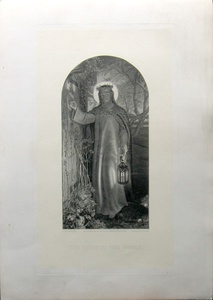| Method | Engraving |
| Artist | William Ridgway after Holman Hunt |
| Published | Published 12 May 1863 by Gambart & Co. |
| Dimensions | Image 304 x 152, Plate 442 x 254 mm |
| Notes |
William Ridgway's engraving of The Light of the World is a great example of Ernest Gambart's perspicacious approach to business. Though Holman Hunt's original painting was completed a decade beforehand, Gambart sent it on an eighteen month tour of England and the Channel Islands in order to orchestrate a revival of interest in the work. Ridgway's small format engraving accompanied the original, and sold prolifically. The Light of the World is not only one of the defining works of Pre-Raphaelitism, but one of the most celebrated paintings of the Victorian period. Christ is depicted as a king. He is adorned with a second crown of thorns and a decorated mantle. In his right hand he carries a lantern, whilst he knocks on the door of a cottage with his left. The subtleties of the symbolism and the scriptural basis of the work are by now a thing of anecdote. The original work resides in the chapel of Keble College, Oxford, after the widow of Thomas Combe donated the work in 1872. William Ridgway (1855 - 1885 fl.) was an English reproductive engraver who worked in steel. He was situated in London, but enjoyed a protracted stay in New York. His works were published in the Art Journal, which existed in order to promote art by distributing specially commissioned works by means of a lottery amongst its members. William Holman Hunt (1827-1910) was a Victorian painter, etcher and watercolourist. He entered the Royal Academy Schools in 1844 where he met John Everett Millais, who was to become his closest friend. He was a founding member of the Pre-Raphaelite Brotherhood and adhered to their principles throughout a long career in the arts. From the 1870's onwards, Hunt concentrated on religious themes informed by successive visits to the Holy Land. He was not the first nineteenth-century artist to journey to the East; David Wilkie and David Roberts were but a few that had gone before him. He was however the first to depict the land with such imaginative grandeur and minute detailing. He published his autobiographical Pre-Raphaelitism and the Pre-Raphaelite Brotherhood in 1905. Ernest Gambart (1814 - 1902) was an influential printseller and publisher who, like John Boydell in the eighteenth-century, held a considerable influence over the English art market. Gambart was born in Kortrijk, a municipality in the West of Flanders; he was the son of a printer, binder and bookseller. He soon became known to the print publisher Adolphe Goupil, who sent Gambart to England in order to establish a branch of his firm, Goupil & Cie. Two years later he established his own business by the name of Gambart & Junin, which specialised in the importation of European prints. It is through this manner that the work of Alma-Tadema became recognised in England. From 1848, he began dealing in paintings as well, and was on intimate terms with Pre-Raphaelite artists such as Millais, Hunt, Rossetti and Madox Brown. He retired in 1870, and was succeeded in business by Pilgeram and Lefèvre. Probably ii/iii a lettered proof on of 100 impressions at £1/1 |
| Framing | unmounted |
| Price | £700.00 |
| Stock ID | 11278 |

